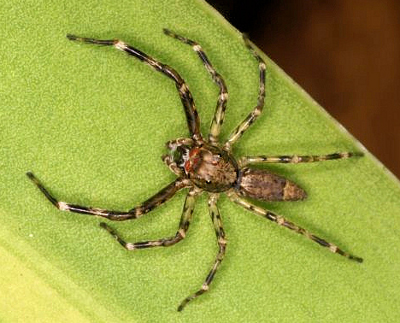Bronze Jumping Spider
Category: Arachnida Spider

Facts about Bronze Jumping Spider, "Scientific name for Bronze Jumping Spider is Helpis". Bronze jumping spiders are brown and cream in color and normally found under leafs of certain trees and known for their taste for small insects. The type of spider is about 10 mm long, thick and strong and very adaptive to its surrounding in terms of survival.
The favorite foods for a bronze Jumping spider are basically moths and other delicious insects that may come across its way, may survive the purpose of quenching its hunger.
The Jumping spider is characterized in living in isolated places where it can breed freely away from its predators; the bronze jumping spiders build silk egg sacs in leaves with their main habitat as foliage.
A Bronze Jumping Spiders stomach can only take liquids, so a spider needs to liquefy their food before they eat. They bite on their prey and empty its stomach liquids into the pray which turns it into a soup for them to drink.
A male Bronze Jumping Spider has two appendages called "pedipalps" a sensory organ, instead of a penis, which is filled with sperm and insert by the male into the female Bronze Jumping Spider’s reproductive opening.
Below is a general information about the bronze jumping spider as per animal classification is concerned:
The bronze Jumping spider is a small but very fuzzy when it comes to jumping and targeting it’s pray, with the fanciful eight strong legs, its very are they miss their target when hunting. They also have the ability to use their beautiful legs to a zigzag lap dance whenever possible to impress their female friends.
This type of species in the kingdom animalia not only impresses but also comes in every color, the size and color entirely depends on its immediate environment and exposure.
Bronze Jumping Spiders have oversize brains.
In the Bronze Jumping Spider the oxygen is bound to "hemocyanin" a copper-based protein that turns their blood blue, a molecule that contains copper rather than iron. Iron-based hemoglobin in red blood cells turns the blood red
Mother Nature has much to offer as per both big and small animals in our planets are concerned. It’s not very common to come across this type of spider just anyway in the world, as some of this rare species faces extinction and change environment makes it tough to survive.
The bronze jumping spider is the most known and beneficial Arachnida since it not only can jump but also can entertain you as you enjoy its natural beauty and color.
Spiders belong to a group of animals called "arachnids", mites and Scorpions and a tick is also in the arachnid family. An Arachnids is a creature with eight legs, two body parts, no antennae or wings and are not able to chew on food. Spiders are not insects because insects have three main body parts and six legs and most insects have wings.
The Arachnids are even in a larger group of animals called "arthropods" an invertebrate animal of the large phylum Arthropoda, which also include spiders, crustaceans and insects. They are the largest group in the animal world, about 80% of all animals come from this group. There are over a million different species. There are more than 40,000 different types of spiders in the world.
Bronze Jumping Spiders have two body parts, the front part of the body is called the Cephalothorax-(the thorax and fused head of spiders). Also on this part of the body is the spider’s gland that makes the poison and the stomach, fangs, mouth, legs, eyes and brain. Spiders also have these tiny little leg-type things called (pedipalps) that are next to the fangs. They are used to hold food while the spider bites it. The next part of the Bronze Jumping Spiders body is the abdomen and the abdomens back end is where there is the spinnerets and where the silk producing glands are located.
The muscles in a Bronze Jumping Spiders legs pull them inward, but the spider can't extend its legs outward. It will pump a watery liquid into its legs that pushes them out. A Bronze Jumping Spider’s legs and body are covered with lots of hair and these hairs are water-repellent, which trap a thin layer of air around the body so the Bronze Jumping Spiders body doesn't get wet. It allows them to float, this is how some spiders can survive under water for hours. A Bronze Jumping Spider feels its prey with chemo sensitive hairs on its legs and than feels if the prey is edible. The leg hair picks up smells and vibrations from the air. There are at minimum, two small claws that are at the end of the legs. Each Bronze Jumping Spiders leg has six joints, giving the Bronze Jumping Spider 48 leg joints. The Bronze Jumping Spider’s body has oil on it, so the spider doesn't stick to it’s own web.
Bronze Jumping Spiders do not have a skeletons. They have a hard outer shell called an exoskeleton-(a rigid external covering for the body in some invertebrate animals). The exoskeleton is hard, so it can’t grow with the spider. The young Bronze Jumping Spiders need to shed their exoskeleton. The Bronze Jumping Spider has to climb out of the old shell through the cephalothorax. Once out, they must spread themselves out before the new exoskeleton will harden. Know they have some room to grow. They stop growing once they fill this shell. Female Bronze Jumping Spiders are usually bigger than males.
Female spiders lay eggs on a bed of silk, which she creates right after mating. Once the female Bronze Jumping Spider lays her eggs, she will than cover them with more silk.

 Back To Category Arachnida Spider
Back To Category Arachnida Spider